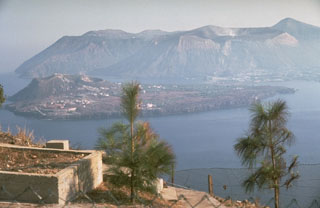Report on Vulcano (Italy) — 17 November-23 November 2021
Smithsonian Institution / US Geological Survey
Weekly Volcanic Activity Report, 17 November-23 November 2021
Managing Editor: Sally Sennert.
Please cite this report as:
Global Volcanism Program, 2021. Report on Vulcano (Italy) (Sennert, S, ed.). Weekly Volcanic Activity Report, 17 November-23 November 2021. Smithsonian Institution and US Geological Survey.
Vulcano
Italy
38.404°N, 14.962°E; summit elev. 500 m
All times are local (unless otherwise noted)
According to an order issued by the Municipality of Lipari that went into effect on 22 November, residents within three high-risk zones (with an exception for the Lentia village) on Vulcano were not allowed to stay overnight in their homes between the hours of 2300-0600 due to an increase in carbon dioxide emissions in area to the N of La Fossa Crater. Residents in a lower-risk zone were allowed to stay in their homes but not sleep on the first floor. In addition, non-residents were banned from visiting the island for 30 days except for essential workers. The Dipartimento della Protezione Civile maintained the Alert Level at Yellow (the second lowest level on a four-color scale).
Geological Summary. The word volcano is derived from Vulcano stratovolcano in Italy's Aeolian Islands. Vulcano was constructed during six stages over the past 136,000 years. Two overlapping calderas, the 2.5-km-wide Caldera del Piano on the SE and the 4-km-wide Caldera della Fossa on the NW, were formed at about 100,000 and 24,000-15,000 years ago, respectively, and volcanism has migrated north over time. La Fossa cone, active throughout the Holocene and the location of most historical eruptions, occupies the 3-km-wide Caldera della Fossa at the NW end of the elongated 3 x 7 km island. The Vulcanello lava platform is a low, roughly circular peninsula on the northern tip of Vulcano that was formed as an island beginning more than 2,000 years ago and was connected to the main island in about 1550 CE. Vulcanello is capped by three pyroclastic cones and was active intermittently until the 16th century. Explosive activity took place at the Fossa cone from 1898 to 1900.
Sources: Municipality of Lipari, Dipartimento della Protezione Civile

